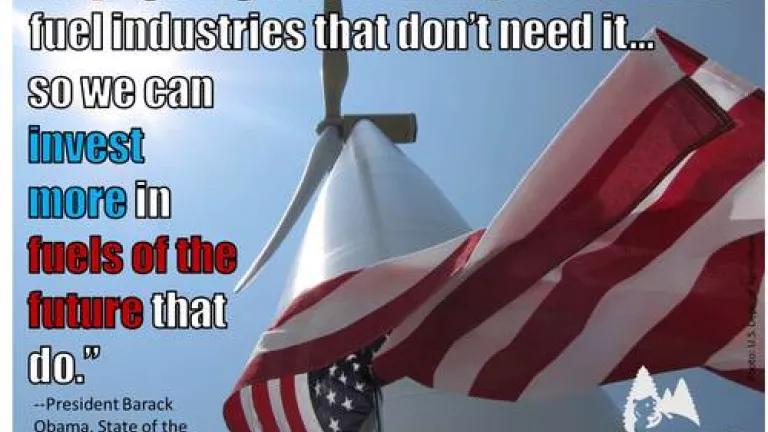
Along with reaffirming his commitment to double-down on America’s energy efficiency to help counter the worst effects of climate change, President Obama used last night’s State of the Union address to challenge Congress to act to ensure our national policies fully support the nation’s transition to a clean energy economy.
The president touted energy efficiency’s amazing success in his speech and the accompanying documents released by the White House, but there wasn’t time to list all the great energy-saving initiatives under way in the United States. Even so, much more work needs to be done to advance efficiency—our cheapest resource—and renewables like wind and solar, especially in Congress. And that begins with Congress renewing— and expanding—the clean energy tax incentives it let expire on December 31, while billions in subsidies continue to big polluters.
The president agreed we need to stop “giving $4 billion a year to fossil fuel industries that don't need it, so that we can invest more in fuels of the future that do.” That means moving from the dirty fuels that poison our planet – and toward clean, renewable energy that’s creating good jobs in our country and helping cut pollution. As President Obama so eloquently reaffirmed, and NRDC President Frances Beineke notes today, we have a moral obligation to act on climate change for the sake of our children. And we’re going to need every energy efficiency solution, wind farm, and solar panel we can get built – along with establishing pollution standards for our power plants—in order to succeed.
Congress needs to do its part
That’s why the first thing Congress must do is reinstate—and expand—the tax incentives for energy efficiency and renewable resources proven to cut energy bills and create thousands of jobs. Because of congressional inability to provide permanent, predictable support, our nation’s clean-energy sector keeps getting stuck in a boom-bust cycle.
Congress also must remove the “light-bulb rider” tacked onto the federal budget that’s preventing the government from spending money to enforce or implement energy efficiency standards for light bulbs signed into law by President Bush in 2007. The rider is a political stunt, with serious consequences. After all, bulb makers are complying and expanding our choices of energy-saving lights, from squiggly CFLs to super-efficient LEDs to new styles of efficient incandescents. And the law will cut more than a $100 a year from individual household electricity bills—and save enough electricity nationally to feed all the homes in Texas—while preventing the same amount of pollution as taking 17 million cars off the roads each year. Unfortunately, Congress’s rider preventing enforcement opens the door for foreign manufacturers to sell substandard bulbs in the United States and undercuts American companies complying with the new standards. That’s wrong—and Congress needs to fix it.
Efficiency is working
Last night, President Obama acknowledged the necessary shift “to a cleaner energy economy won’t happen overnight.” But energy efficiency already has contributed more to meeting the nation’s energy needs over the past four decades than all fossil and nuclear resources combined. We’ve found so many innovative ways to save energy over the past 40 years that we more than doubled the economic productivity of our oil, natural gas and electricity. We need to continue this progress because it means we need less electricity generated by dirty power whose emissions are warming our planet.
Here are a few ways efficiency is helping:
- Establishing standards to cut energy waste in our buildings and appliances will save tremendous amounts of electricity and represents a key part of President Obama’s climate plan. Seven government standards on appliance efficiency, ranging from the standby energy use of our microwaves to the refrigerated display cases in our supermarkets, that were finalized or proposed in 2013, alone, will eventually save consumers and businesses almost $100 billion. They'll also eventually cut more than 23 quads of energy—almost a quarter of the energy we use as a nation in one year. Meanwhile, previously approved standards to cut energy waste in our refrigerators, washers and dryers, dishwashers, air conditioners and commercial and industrial equipment continue to save us money today. For all these reasons, it’s important that the Department of Energy continue to meet its deadlines for establishing new energy-saving standards and also update current ones as technology advances.
- America’s electric and natural gas utilities are working harder to help customers save energy. According to the most recent figures available, they budgeted an estimated $8.3 billion in 2012 on programs that help customers conserve and also shift use to off-peak hours. That’s more than twice the amount spent just four years before. Substantial progress is being made in several states, including California and Michigan.
- The 230 million set-top boxes installed in America’s homes by cable, satellite and telephone companies are about use a lot less energy. The pay-TV industry, NRDC and other energy-efficiency advocacy groups reached an agreement just before Christmas to take steps to cut energy use by these ubiquitous black boxes by 10 percent to 45 percent, saving consumers $1 billion a year.
- Automotive fuel efficiency is soaring. Model year 2012 vehicles achieved an all-time high fuel economy of 23.6 miles per gallon (mpg), a 1.2 mpg increase over the previous year. Fuel economy has increased in seven of the last eight years. The president last night talked about setting new standards for our trucks, “so we can keep driving down oil imports and what we pay at the pump.” That’s important because the transportation sector accounts for roughly one-third of national carbon dioxide emissions, and is the second largest emitter behind power plants.
President Obama used his State of the Union address to celebrate the progress of energy efficiency in creating our nation’s future and reaffirm leadership on climate. Shouldn’t Congress do the same?


